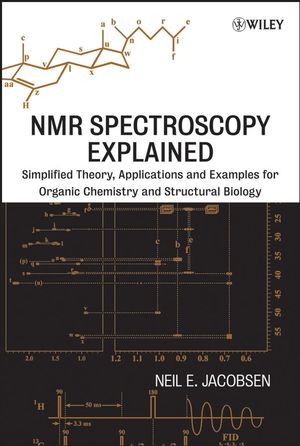NMR Spectroscopy Explained: Simplified Theory, Applications and Examples for Organic Chemistry and Structural BiologyISBN: 978-0-471-73096-5
Hardcover
688 pages
August 2007
 This is a Print-on-Demand title. It will be printed specifically to fill your order. Please allow an additional 15-20 days delivery time. The book is not returnable.
|
||||||
Acknowledgments.
1 Fundamentalsof NMR Spectroscopy in Liquids.
1.1 Introduction to NMR Spectroscopy.
1.2 Examples: NMR Spectroscopy of Oligosaccharides and Terpenoids.
1.3 Typical Values of Chemical Shifts and Coupling Constants.
1.4 Fundamental Concepts of NMR Spectroscopy.
2 Interpretation of Proton (1H) NMR Spectra.
2.1 Assignment.
2.2 Effect of Bo Field Strength on the Spectrum.
2.3 First-Order Splitting Patterns.
2.4 The Use of 1H–1H Coupling Constants to Determine Stereochemistry and Conformation.
2.5 Symmetry and Chirality in NMR.
2.6 The Origin of the Chemical Shift.
2.7 J Coupling to Other NMR-Active Nuclei.
2.8 Non-First-Order Splitting Patterns: Strong Coupling.
2.9 Magnetic Equivalence.
3 NMR Hardware and Software.
3.1 Sample Preparation.
3.2 Sample Insertion.
3.3 The Deuterium Lock Feedback Loop.
3.4 The Shim System.
3.5 Tuning and Matching the Probe.
3.6 NMR Data Acquisition and Acquisition Parameters.
3.7 Noise and Dynamic Range.
3.8 Special Topic: Oversampling and Digital Filtering.
3.9 NMR Data Processing—Overview.
3.10 The Fourier Transform.
3.11 Data Manipulation Before the Fourier Transform.
3.12 Data Manipulation After the Fourier Transform.
4 Carbon-13 (13C) NMR Spectroscopy.
4.1 Sensitivity of 13C.
4.2 Splitting of 13C Signals.
4.3 Decoupling.
4.4 Heteronuclear Decoupling: 1H Decoupled 13C Spectra.
4.5 Decoupling Hardware.
4.6 Decoupling Software: Parameters.
4.7 The Nuclear Overhauser Effect (NOE).
4.8 Heteronuclear Decoupler Modes.
5 NMR Relaxation—Inversion-Recovery and the Nuclear Overhauser Effect (NOE).
5.1 The Vector Model.
5.2 One Spin in a Magnetic Field.
5.3 A Large Population of Identical Spins: Net Magnetization.
5.4 Coherence: Net Magnetization in the x–y Plane.
5.5 Relaxation.
5.6 Summary of the Vector Model.
5.7 Molecular Tumbling and NMR Relaxation.
5.8 Inversion-Recovery: Measurement of T1 Values.
5.9 Continuous-Wave Low-Power Irradiation of One Resonance.
5.10 Homonuclear Decoupling.
5.11 Presaturation of Solvent Resonance.
5.12 The Homonuclear Nuclear Overhauser Effect (NOE).
5.13 Summary of the Nuclear Overhauser Effect.
6 The Spin Echo and the Attached Proton Test (APT).
6.1 The Rotating Frame of Reference.
6.2 The Radio Frequency (RF) Pulse.
6.3 The Effect of RF Pulses.
6.4 Quadrature Detection, Phase Cycling, and the Receiver Phase.
6.5 Chemical Shift Evolution.
6.6 Scalar (J) Coupling Evolution.
6.7 Examples of J-coupling and Chemical Shift Evolution.
6.8 The Attached Proton Test (APT).
6.9 The Spin Echo.
6.10 The Heteronuclear Spin Echo: Controlling J-Coupling Evolution and Chemical Shift Evolution.
7 Coherence Transfer: INEPT and DEPT.
7.1 Net Magnetization.
7.2 Magnetization Transfer.
7.3 The Product Operator Formalism: Introduction.
7.4 Single Spin Product Operators: Chemical Shift Evolution.
7.5 Two-Spin Operators: J-coupling Evolution and Antiphase Coherence.
7.6 The Effect of RF Pulses on Product Operators.
7.7 INEPT and the Transfer of Magnetization from 1H to 13C.
7.8 Selective Population Transfer (SPT) as a Way of Understanding INEPT Coherence Transfer.
7.9 Phase Cycling in INEPT.
7.10 Intermediate States in Coherence Transfer.
7.11 Zero- and Double-Quantum Operators.
7.12 Summary of Two-Spin Operators.
7.13 Refocused INEPT: Adding Spectral Editing.
7.14 DEPT: Distortionless Enhancement by Polarization Transfer.
7.15 Product Operator Analysis of the DEPT Experiment.
8 Shaped Pulses, Pulsed Field Gradients, and Spin Locks: Selective 1D NOE and 1D TOCSY.
8.1 Introducing Three New Pulse Sequence Tools.
8.2 The Effect of Off-Resonance Pulses on Net Magnetization.
8.3 The Excitation Profile for Rectangular Pulses.
8.4 Selective Pulses and Shaped Pulses.
8.5 Pulsed Field Gradients.
8.6 Combining Shaped Pulses and Pulsed Field Gradients: "Excitation Sculpting."
8.7 Coherence Order: Using Gradients to Select a Coherence Pathway.
8.8 Practical Aspects of Pulsed Field Gradients and Shaped Pulses.
8.9 1D Transient NOE using DPFGSE.
8.10 The Spin Lock.
8.11 Selective 1D ROESY and 1D TOCSY.
8.12 Selective 1D TOCSY using DPFGSE.
8.13 RF Power Levels for Shaped Pulses and Spin Locks.
9 Two-Dimensional NMR Spectroscopy: HETCOR, COSY, and TOCSY.
9.1 Introduction to Two-Dimensional NMR.
9.2 HETCOR: A 2D Experiment Created from the 1D INEPT Experiment.
9.3 A General Overview of 2D NMR Experiments.
9.4 2D Correlation Spectroscopy (COSY).
9.5 Understanding COSY with Product Operators.
9.6 2D TOCSY (Total Correlation Spectroscopy).
9.7 Data Sampling in t1 and the 2D Spectral Window.
10 Advanced NMR Theory: NOESY and DQF-COSY.
10.1 Spin Kinetics: Derivation of the Rate Equation for Cross-Relaxation.
10.2 Dynamic Processes and Chemical Exchange in NMR.
10.3 2D NOESY and 2D ROESY.
10.4 Expanding Our View of Coherence: Quantum Mechanics and Spherical Operators.
10.5 Double-Quantum Filtered COSY (DQF-COSY).
10.6 Coherence Pathway Selection in NMR Experiments.
10.7 The Density Matrix Representation of Spin States.
10.8 The Hamiltonian Matrix: Strong Coupling and Ideal Isotropic (TOCSY) Mixing.
11 Inverse Heteronuclear 2D Experiments: HSQC, HMQC, and HMBC.
11.1 Inverse Experiments: 1H Observe with 13C Decoupling.
11.2 General Appearance of Inverse 2D Spectra.
11.3 Examples of One-Bond Inverse Correlation (HMQC and HSQC) Without 13C Decoupling.
11.4 Examples of Edited, 13C-Decoupled HSQC Spectra.
11.5 Examples of HMBC Spectra.
11.6 Structure Determination Using HSQC and HMBC.
11.7 Understanding the HSQC Pulse Sequence.
11.8 Understanding the HMQC Pulse Sequence.
11.9 Understanding the Heteronuclear Multiple-Bond Correlation (HMBC) Pulse Sequence.
11.10 Structure Determination by NMR—An Example.
12 Biological NMR Spectroscopy.
12.1 Applications of NMR in Biology.
12.2 Size Limitations in Solution-State NMR.
12.3 Hardware Requirements for Biological NMR.
12.4 Sample Preparation and Water Suppression.
12.5 1H Chemical Shifts of Peptides and Proteins.
12.6 NOE Interactions Between One Residue and the Next Residue in the Sequence.
12.7 Sequence-Specific Assignment Using Homonuclear 2D Spectra.
12.8 Medium and Long-Range NOE Correlations.
12.9 Calculation of 3D Structure Using NMR Restraints.
12.10 15N-Labeling and 3D NMR.
12.11 Three-Dimensional NMR Pulse Sequences: 3D HSQC–TOCSY and 3D TOCSY–HSQC.
12.12 Triple-Resonance NMR on Doubly-Labeled (15N, 13C) Proteins.
12.13 New Techniques for Protein NMR: Residual Dipolar Couplings and Transverse Relaxation Optimized Spectroscopy (TROSY).
Appendix A: A Pictorial Key to NMR SpinStates.
Appendix B: A Survey of Two-Dimensional NMR Experiments.
Index.



